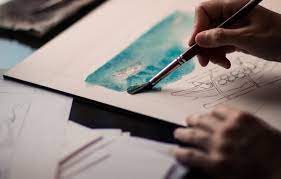The Many Benefits Of Creating Art

Creating art is a very effective way to stimulate the mind and anyone can do it. Learn the many benefits of art and how it can help you.
There’s a huge misconception about being an artist. Most people believe that you are born with talent, and creating art is limited to the lucky few. While we can’t all be Van Goghs, the desire to create can have long term benefits. If you’ve ever had the urge to embrace your artistic side, why not try?
Enjoy the process and create art as a way to reignite your imagination, stimulate your mind and improve your overall well-being
Here are a few ways even us "non-artists" can benefit from art:
** Stress Relief **
Research has shown that engaging in just 45 minutes of art-making significantly reduced the levels of cortisol (aka “the stress hormone”) across 75% of participants. Why? Well, it turns out, creating art is akin to meditation. It forces the mind to slow down, to focus on the details, and it helps to block out the mind’s distractions, resulting in people feeling noticeably calmer and less anxious.
** Confidence Boost **
Remember being a kid, and the feeling of pride you would feel when your mom hung your artwork up on the fridge or wall for all the world to see? It turns out, that feeling doesn’t go away as an adult. Seeing a completed work of art that you have created stimulates the release of dopamine—the feel-good hormone—into our bodies, which lowers feelings of depression and increases feelings of confidence. In other words, creating art makes you feel better about yourself. Even if it’s just a stick figure.
** Problem Solving **
That’s right, creating art can help us become better problem solvers. There are two reasons for this. One is that the practice of creating is inherently without boundaries or parameters. It forces you to use your imagination, to think through how you are going to convey your image or message through art. And the habit of thinking creatively helps you to learn new, resourceful ways of solving problems in your art, but also in life.
But secondly, the process of turning our problems into narratives can help us to work through them. By organizing our problems into the framework of a narrative—be it through writing, song or visual art—it helps to bring a sense of order to the chaos that is represented in the problem. This, in turn, “gives individuals a sense of predictability and control over their lives.”
*** Improves Quality Of Life For Those With Illness **
Not only does art-making help to reduce symptoms of anxiety and depression that are commonly experienced by those suffering from chronic illness, but researchis also showing that it can be quite beneficial to older adults, particularly those suffering from Alzheimer’s or Parkinson’s disease. This is because making art can improve cognitive functions by strengthening, or even creating new neural pathways in the brain, helping the brain to adapt and stay healthier. In fact, the earlier we can start using our creative brain regularly, and the longer we continue to do so, can help the brain stay fit and healthy as we age.
As a species, we have yet to run out of ways to creatively express ourselves. And in light of what research is now revealing are the many benefits of art-making; perhaps the very success of our species can be attributed, at least in part, to our innate need to create. It stimulates progress, it helps us cope, and more than anything, it helps us frame the narrative of our own humanity.

